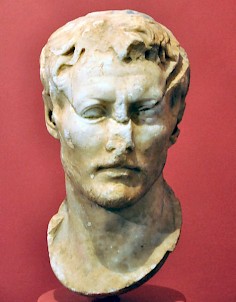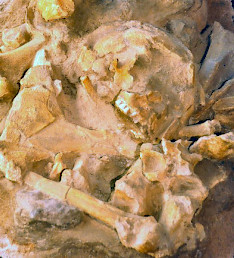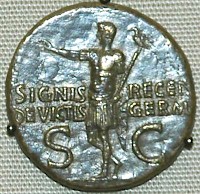Teutoburg Forest (7)
Battle in the Teutoburg Forest (Latin Saltus Teutoburgiensis): the defeat of the Roman commander Publius Quintilius Varus against the Germanic tribesmen of the Cheruscian leader Arminius in 9 CE. In this battle, three legions (XVII, XVIII, XIX) were annihilated.
Aftermath

Although groups of survivors reached the Lippe valley, the Roman army that had permanently been under attack since it had passed through the Kalkriese narrows, no longer existed. Tacitus tells how captured officers were sacrificed to Germanic gods. Other Roman captives were to serve as slaves, although some of them were later ransomed, and returned to the Roman world. But this happened later.
Cassius Dio and Velleius Paterculus continue their account of the ambushed army almost identically with the story that there was one fortress in Germania that remained in Roman hands.
The valor of Lucius Caedicius, prefect of the camp, deserves praise, and of those who, pent up with him at Aliso, were besieged by an immense force of Germans. For, overcoming all their difficulties which want rendered unendurable and the forces of the enemy almost insurmountable, following a design that was carefully considered, and using a vigilance that was ever on the alert, they watched their chance, and with the sword won their way back to their friends.note
Dio tells the story in greater detail (text) but does not mention the name of the fortress. It must have been a large stronghold (it had a prefect and is called a castra) in the valley of the Lippe. The name Aliso suggests that it is identical with the fortress that Drusus had built near the river Elison, Oberaden; but this had been evacuated in 8 BCE. On the other hand, Aliso is not the same as Elison, and perhaps we are allowed to identify the fortress with Haltern, which perfectly suits Dio's and Paterculus' words. It was hastily evacuated: in one of the potter's pits, at least twenty-four soldiers were buried; weapons were stored away; coins were buried in hoards; much pottery survives intact.

Tacitus also mentions Aliso, but in another context.note He says that there was a tomb for soldiers of the legions of Varus. Unless this refers to the tomb that was later built on the main battlefield, this suggests that survivors of the battle in the Teutoburg Forest were killed during the escape from Aliso, which in turn proves that survivors of the Kalkriese ambush and the disintegration of the Roman army - as we have seen above, possibly in the Ems valley east of Münster - arrived in the Lippe valley.
Other Roman soldiers from Germania had already reached the Rhine, and the news that something terrible had happened spread upstream along the river. From Mainz, general Lucius Nonius Asprenas (Varus' nephew) immediately sent his legions, I Germanica and V Alaudae, to the north and occupied the fortresses of Cologne and Xanten. This prevented the Germanic tribes from invading Gaul. At the same time, general Tiberius (the future emperor) marched from the Danube to the Rhineland with the legions XX Valeria Victrix and XXI Rapax, and prepared for renewed war.
In Rome, the populace was afraid, and the emperor Augustus ordered that watch be kept by night throughout the city.
He was so greatly affected that for several months in succession he cut neither his beard nor his hair, and sometimes he could dash his head against a door, crying "Quintilius Varus, give me back my legions!"note
During the winter, Arminius created a new tribal coalition. Varus' dead body had been identified by the Germanic warriors, who cut off the Roman's head and sent it to king Maroboduus, the leader of the Marcomanni, hoping that he would join the general insurrection. However, he refused, and sent Varus' remains to Rome, where Augustus buried the head in the mausoleum of his own family.
After three campaigns (in 9, 10 and 11), Tiberius thought that the Germanic tribes had been punished sufficiently, and he celebrated a triumph in 12. He also decided not to try to occupy the country east of the Rhine anymore. This was not surprising: he had already taken a similar decision in 8 BCE. During his reign as emperor (14-37), Tiberius was to stick to this policy.
This does not mean that he ignored the northern frontier. No less than eight legions were to guard the Rhine:
- at Windisch, XIII Gemina; at Strasbourg, II Augusta; at Mainz, XIV Gemina and XVI Gallica. This was the army of Germania Superior, based along the Middle Rhine.
- The army of Germania Inferior was stationed along the Lower Rhine: at Bonn, I Germanica, at Neuss, XX Valeria Victrix, and finally V Alaudae and XXI Rapax in Xanten.
These two armies were commanded by the son of Tiberius' brother Drusus, Germanicus.
Germanicus

During the autumn of 14, the army of Germania Inferior unexpectedly invaded "free" Germania. The cause was probably that the soldiers were unquiet after the death of Augustus and the accession of Tiberius, and Germanicus wanted to give them something else to think about.
Part of the cavalry, and some of the auxiliary cohorts led the van; then came the First Legion, and, with the baggage in the center, the men of the Twenty-First closed up the left, those of the Fifth, the right flank. The Twentieth Legion secured the rear, and, next, were the rest of the allies.note
This is an interesting line, because it shows that Germanicus understood that he had to cover his flanks, something that Varus had probably not. This force reached the Marsi on the Upper Lippe and the Bructeri on the Upper Ems. In other words, the army moved south and north of the Lippe valley, which was, for reasons unknown to us, no longer a point of interest. However, there are indications that the Romans had occupied part of this zone (e.g., Tacitus describes that Germanic warriors besieged a fortress in the Lippe valley).note
Next year saw spectacular actions. In the spring, Germanicus led the army of Germania Superior against the Chatti, destroyed an important settlement, reached the Upper Weser, liberated the pro-Roman Germanic leader Segestes, and captured Arminius' wife Thusnelda. At the same time, his adjutant Caecina ordered the army of Germania Inferior to attack the Marsi again. This prevented other tribes, like the Cherusci, from supporting the Chatti.

In the summer, Caecina attacked the Bructeri along the Upper Ems again. The soldiers of one of his colonels, Lucius Stertinius, found back the eagle standard of the Nineteenth Legion. Germanicus himself went to the country of the Batavians (perhaps to Vechten), where he placed four legions on ships, and sailed along the country of the Frisians and Chauci, who surrendered. Now, Germanicus could proceed to the Ems, and from the area of Münster, he marched to the Teutoburg Forest, where he buried the dead. At least, that is what Tacitus tells us. The problem is that he tells that Germanicus' army first reached Varus' first camp, then the second camp, and finally the place where Varus committed suicide. This is a movement from east to west, whereas Germanicus in fact must have moved from west to east. Probably, Tacitus could not resist the temptation to give a more climactic description.
However this may be, we are certain that a burial took place at the Kalkriese, where five pits were found that contained the (often cut) bones of many adult males. The skeletons seem to have been exposed for a few years before they were finally buried.
After the burial, Germanicus' army proceed to the Cherusci, where a non-conclusive skirmish was fought against Arminius. After this, Germanicus ordered his army to return, but he was pursued by Arminius. Germanicus' army was able to leave this theater of operations, so Arminius now pursued Caecina's army, which was still in the neighborhood and tried to return over the pontes longi through the bog area between the Ems and Lippe. We already noted above that Caecina dreamt that he saw Varus, and that Arminius addressed his soldiers, comparing the situation to the last hours of Varus.

In the year 16, Germanicus built a large fleet that was to be gathered in the country of the Batavians, near modern Nijmegen. Before he could start the naval expedition, however, Germanic warriors laid siege to a Roman fortress in the valley of the Lippe. They had already destroyed a tomb of Roman soldiers that had belonged to the three legions of Varus. Germanicus restored order (but not the tomb) and the area between the Rhine and Aliso was occupied again.
Germanicus now launched the naval attack. The navy sailed through the canal of Drusus and along the country of the Frisians and Chauci again, and the army landed in the valley of the Upper Ems. From here, it marched to the east, where it encountered the army of Arminius at a place called Idistaviso, on the east bank of the Weser. The river was first crossed by the Batavian regiment. Its commander Chariovalda played, according to Tacitus, a heroic role. In the ensuing battle, Arminius was defeated by eight legions. To show the Roman strength, Germanicus sent back part of his army through open country. A victory monument was built in Nijmegen, the capital of the Batavians.
Germanicus' successes were considerable: the Lippe valley and the North Sea coast had been reconquered, Arminius defeated, Roman prestige restored. It was up to the emperor Tiberius to decide what to do next: to accept the conquests and return to the aggressive policy of Augustus, or to stick to his own position, and leave the Germanic tribes alone. He chose the latter: the Lippe valley was evacuated by the Romans, and the tribes, left alone, started to fight against each other. Arminius was murdered, Germanicus recalled.
It was a wise decision. During the next decades, the Roman legions were sometimes to invade Germania, and Roman diplomats were always able to create disputes among the tribes. For more than two centuries, the west bank of the Rhine was safe.
Assessment
It is possible to overstate the importance of the battle in the Teutoburg Forest. This certainly happened in the nineteenth century, when, especially in Germany, Arminius, and Varus became symbols of an eternal opposition between the noble Germanic savages and their decadent, Latin speaking archenemies - the French.
This eternal opposition is simply nonsense. After the horrors of the First World War, the great Belgian historian Henri Pirenne (1862-1935) was among the first to oppose the idea, but Europe needed a Robert Schuman and a Konrad Adenauer to understand it. From the reign of Louis XIV to the Second World War, control of the Rhine has been a source of conflict between France and Germany, but the Rhineland has always remained a zone where two European cultures met and exchanged experiences.
Yet, the battle was important. The Roman Empire had met its limits. Tiberius accepted that there were areas without towns that were not predigested for Roman rule. During the next centuries, the Germanic tribes learned from Rome, and Rome learned from them. But always, Germania retained some of its independence.
This had serious consequences. One example may suffice to illustrate this: if the Romans had kept the country between the Rhine and Elbe, the North Sea tribes that were later known as Saxons would have spoken Latin. The English language would - for better or worse - never have existed, and German would have been marginal. The great linguistic division of today's western world would simply not exist without the battle in the Teutoburg Forest. But the fights were not the cause of this rift; they were a precondition.
Literature
- T. Clunn, In Quest of the Lost Legions (1999) [updated edition 2005]
- Joachim Harnecker, Arminius, Varus und das Schlachtfeld von Kalkriese. Eine Einführung in die archäologischen Arbeiten und ihre Ergebnisse (1999) Bramsche
- J. Oorthuys (ed.), "The Varian Disaster. The battle of the Teutoburg Forest", special issue of Ancient Warfare (2009)
- Adrian Murdoch, Rome's Greatest Defeat. Massacre in the Teutoburg Forest (2006)
Museums
Finally, a word about museums. The governments of Germany, Nordrhein-Westfalen, and Niedersachsen deserve the highest praise for creating, in the 1990s, two beautiful museums, which are both very much worth a visit:
- The Kalkriese Museum east of Bramsche;
- The Westfälisches Römermuseum at Haltern.
You can combine a visit to these museums with visits to the reconstructed Roman city at Xanten (the Archäologische Park) and the Römisch-Germanisches Museum at Cologne and have a really nice holiday.